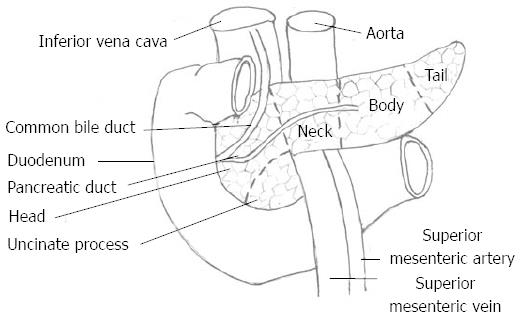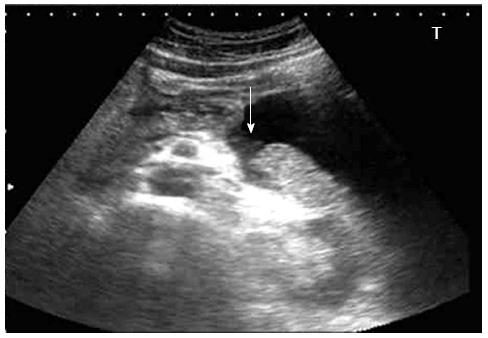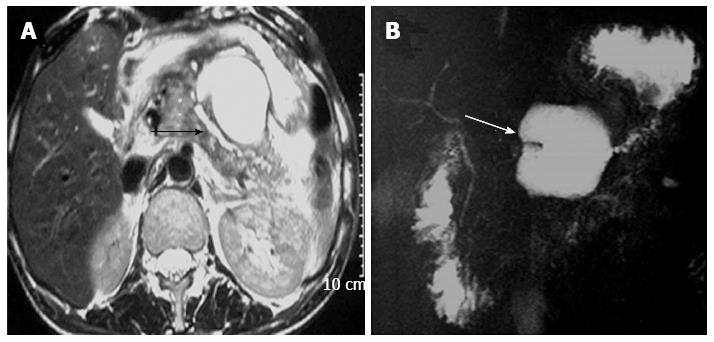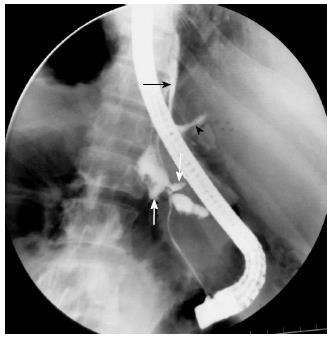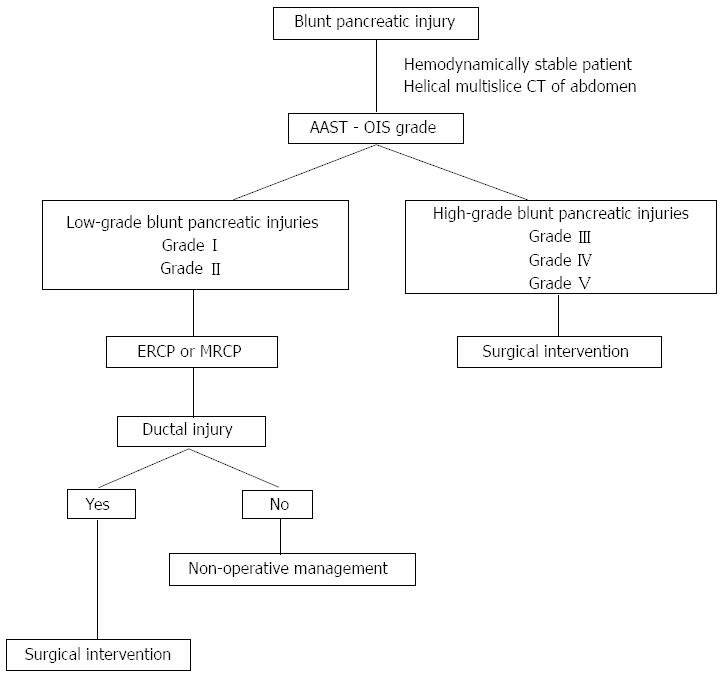Copyright
©2013 Baishideng Publishing Group Co.
World J Gastroenterol. Dec 21, 2013; 19(47): 9003-9011
Published online Dec 21, 2013. doi: 10.3748/wjg.v19.i47.9003
Published online Dec 21, 2013. doi: 10.3748/wjg.v19.i47.9003
Figure 1 Gross anatomy of the pancreas.
Figure 2 Ultrasound image.
Axial ultrasound image shows localized traumatic enlargement of the pancreas with diffuse edema. Transection of distal body of pancreas communicating with large fluid collection anterior to pancreas (white arrow).
Figure 3 Computed tomography images.
A, B: Axial contrast-enhanced computed tomography shows a heterogeneous appearance of the body and tail of pancreas with a linear laceration (white arrow) across the distal body of the pancreas. There is also fluid in the lesser sac, perihepatic space, perisplenic space and hemoperitoneum. There is free air into chest wall muscles on right side in a case of blunt pancreatic trauma (A), and transection throughout extent of pancreatic parenchyma in proximal body region (suggestive of ductal injury) with a large fluid collection (white arrow) anterior to pancreas communication with the transection in another case of blunt injury to upper abdomen (B); C: Contrast-enhanced computed tomography demonstrating mild diffuse hypodensity of the body of pancreas. Contusions of the head and neck also demonstrated (white arrow) with secondary signs of traumatic pancreatitis, i.e., increased density of the peripancreatic fat, thickening of left anterior pararenal fascia, fluid in the lesser sac and hemoperitoneum; D: Plain axial computed tomography section at the level of pancreas shows a large hyperdense hematoma (black arrow) in proximal body of pancreas suggestive of pancreatic injury. E: Multiplanar reconstruction image of contrast-enhanced computed tomography demonstrating a pancreatic fracture (white arrow) in neck region with separation of pancreatic fragments; F: Contrast-enhanced axial computed tomography scan in a child with bicycle handlebar injury more than a month old shows a large lobulated pseudocyst anterior to pancreas communicating with pancreatic laceration in the neck of pancreas representing ductal injury. There is fluid between posterior pancreas and the splenic vein (arrow heads).
Figure 4 Magnetic resonance images.
T2 weighted axial image (A) and magnetic resonance cholangiopancreatography (B) in a case of traumatic pancreatitis show heterogenous signal intensity of pancreas with peripancreatic stranding. Main pancreatic duct is dilated in the body and tail region (black arrow). A lobulated pseudopancreatic cyst is seen in lesser sac anterior aspect of body of pancreas (white arrow) demonstrated in magnetic resonance cholangiopancreatography.
Figure 5 Endoscopic retrograde cholangiopancreatography image.
Another case of traumatic pancreatitis. Fluoroscopic image showing main pancreatic duct disruptions during endoscopic retrograde cholangiopancreatography with multiple contrast filled outpouching is seen, suggestive of pseudocysts (white arrow). Multiple contrast filled tracts are also visualized (black arrowhead). Few tracts are seen in retroperitoneum and one of the tracts is reaching into mediastinum (black arrow). Endoscope is visible.
Figure 6 Management algorithm for traumatic pancreatic injury patients.
Reproduced from Ilahi et al[14]. ERCP: Endoscopic retrograde cholangiopancreatography; MRCP: Magnetic resonance cholangiopancreatography.
- Citation: Debi U, Kaur R, Prasad KK, Sinha SK, Sinha A, Singh K. Pancreatic trauma: A concise review. World J Gastroenterol 2013; 19(47): 9003-9011
- URL: https://www.wjgnet.com/1007-9327/full/v19/i47/9003.htm
- DOI: https://dx.doi.org/10.3748/wjg.v19.i47.9003









